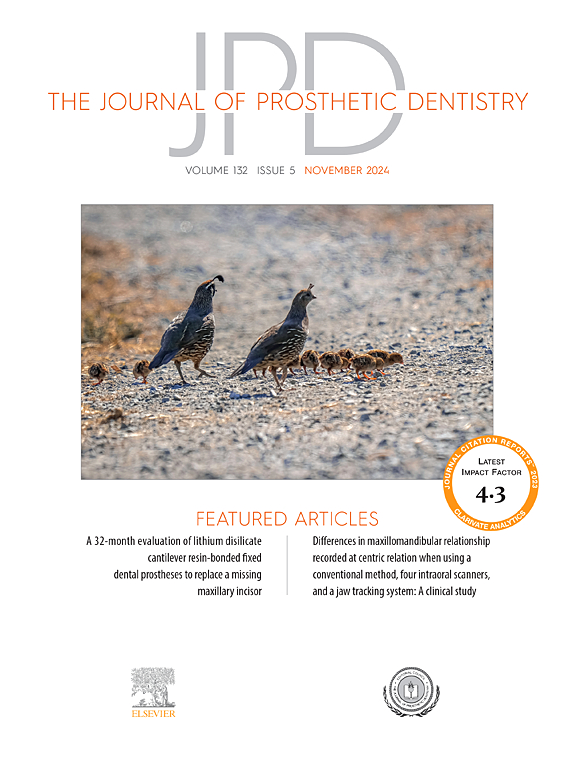Comparison of marginal and internal fit of 10-unit fixed dental prostheses fabricated from cobalt chromium alloys or zirconia ceramics using digital workflows
IF 4.8
2区 医学
Q1 DENTISTRY, ORAL SURGERY & MEDICINE
引用次数: 0
Abstract
Statement of problem
Long-span fixed dental prostheses (FDPs) can be challenging to fabricate with adequate marginal and internal fit. The performance of restorations fabricated from cobalt chromium or zirconia using a completely digital workflow requires further evaluation to ensure clinical acceptability.
Purpose
The purpose of this in vitro study was to evaluate and compare the marginal and internal fit of 10-unit FDPs fabricated from cobalt chromium or zirconia by using digital scanning and computer-aided design and computer-aided manufacturing (CAD-CAM).
Material and methods
Twenty-four complete arch digital scans of a typodont model with 6 prepared teeth were acquired to design and mill 12 cobalt chromium and 12 zirconia 10-unit FDP frameworks. For each framework, measurements from all 6 abutments and from both buccolingual and mesiodistal sections were pooled, yielding 1 mean value per measurement area per specimen. Marginal, chamfer, internal, and overall cement gaps were evaluated with the silicone replica technique. Trueness was defined as the difference between the measured gap and the preset cement spacer. Data were analyzed with 2-sample t tests on the pooled specimen means (α=.05).
Results
Mean gap measurements for cobalt chromium versus zirconia were (gap value ±standard deviation) as follows: marginal, 68.7 ±14.6 µm versus 53.3 ±11.8 µm; chamfer, 66.8 ±10.6 µm versus 58.1 ±10.8 µm; internal, 77.7 ±6.5 µm versus 95.8 ±9.4 µm; and overall cement gap, 74.2 ±8.2 µm versus 81.3 ±9.7 µm. The zirconia restorations exhibited a significantly smaller marginal gap (P=.01), whereas the cobalt chromium frameworks showed a significantly smaller internal gap (P<.001), with the chamfer gap being statistically similar (P=.061). Zirconia demonstrated significantly higher trueness in the marginal area (P=.01), while the internal gap trueness did not differ significantly between the 2 materials (difference 1.9 µm, P=.56). Both materials remained below the 120 µm clinical threshold for acceptable fit.
Conclusions
A digital workflow yielded precise, clinically acceptable fit for 10-unit restorations fabricated from both cobalt chromium and zirconia. Zirconia demonstrated significantly higher marginal trueness, whereas the internal gap trueness did not differ significantly between the 2 materials. Optimizing cement spacer settings and evaluating deviations from the planned spacer are crucial for an accurate assessment of fit.
使用数字工作流程比较钴铬合金和氧化锆陶瓷制作的10单元固定义齿的边缘和内部配合。
问题陈述:大跨度固定牙修复体(fdp)可以具有足够的边缘和内部配合制造挑战。使用完全数字化工作流程制作的钴铬或氧化锆修复体的性能需要进一步评估,以确保临床可接受性。目的:本体外研究的目的是利用数字扫描和计算机辅助设计与计算机辅助制造(CAD-CAM)技术,评价和比较钴铬或氧化锆制备的10单元fdp的边缘和内部配合度。材料和方法:获得24个完整的弓形数字扫描模型和6个准备好的牙齿,设计和铣削12个钴铬和12个氧化锆10单元FDP框架。对于每个框架,将所有6个基牙以及颊部和中远端切片的测量结果汇总,每个标本的每个测量面积产生1个平均值。使用硅胶复制技术评估边缘、倒角、内部和整体水泥间隙。正确度定义为测量间隙与预设水泥间隔的差值。对合并标本均数采用两样本t检验(α= 0.05)。结果:钴铬与氧化锆的平均间隙测量值(间隙值±标准差)如下:边缘,68.7±14.6µm对53.3±11.8µm;倒角,66.8±10.6µm vs 58.1±10.8µm;内部,77.7±6.5µm vs 95.8±9.4µm;总体水泥间隙分别为74.2±8.2µm和81.3±9.7µm。氧化锆修复体显示出更小的边缘间隙(P= 0.01),而钴铬框架显示出更小的内部间隙(p结论:数字化工作流程产生了精确的,临床可接受的10单元钴铬和氧化锆修复体。氧化锆的边缘真实度显著高于氧化锆,而内部间隙真实度在两种材料之间没有显著差异。优化水泥隔离器的设置和评估与计划隔离器的偏差对于准确评估配合至关重要。
本文章由计算机程序翻译,如有差异,请以英文原文为准。
求助全文
约1分钟内获得全文
求助全文
来源期刊

Journal of Prosthetic Dentistry
医学-牙科与口腔外科
CiteScore
7.00
自引率
13.00%
发文量
599
审稿时长
69 days
期刊介绍:
The Journal of Prosthetic Dentistry is the leading professional journal devoted exclusively to prosthetic and restorative dentistry. The Journal is the official publication for 24 leading U.S. international prosthodontic organizations. The monthly publication features timely, original peer-reviewed articles on the newest techniques, dental materials, and research findings. The Journal serves prosthodontists and dentists in advanced practice, and features color photos that illustrate many step-by-step procedures. The Journal of Prosthetic Dentistry is included in Index Medicus and CINAHL.
 求助内容:
求助内容: 应助结果提醒方式:
应助结果提醒方式:


